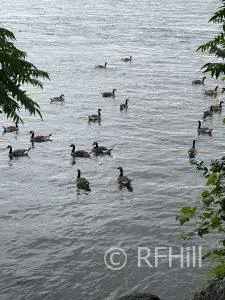There’s something a little bit wild — and wildly poetic — about a place where the St. Lawrence River decides to stop flowing politely and throws itself into a frothy, endless dance. It’s not quite an ocean, not quite a river, and not relatively calm. It’s the Vague à Guy — Montreal’s perpetual wave — and it’s been churning just west of downtown for decades.
Vague à Guy is steps from the bike path and the bird sanctuary at Parc des Rapides, which we often visit. A few weeks ago, we were walking on Le Plateau in Montreal and saw two men on bikes carrying surfboards. I asked Louise what that was all about. After a moment's thought, she mentioned that they were probably surfing at Parc des Rapides. We then made it our mission to follow up and check it out ASAP.
So there we were checking Vague à Guy that very weekend. One moment, I was listening to red-winged blackbirds warble from the reeds, and the next, I was watching women in wetsuits dance into the rapids. And the wave didn’t break — it just stayed there, stubborn as a local on a terrace in April, waiting for spring.
So what is “Vague à Guy”?
First, it’s a play on words — “vague” means wave in French, and “Guy” is both a name and a nod to the legendary local surfer Guy Blanchette, who started surfing the rapids here back in the 1980s. Like all good surf spots, this one was discovered quietly and shared selectively. What began as a daredevil’s playground slowly grew into a community, wetsuit-clad wave chasers showing up year after year, carving river water like it’s salt spray.
But this isn’t your average wave. It's a standing wave — a naturally occurring phenomenon created when fast-moving water flows over a submerged obstacle, like a rock or ledge. Instead of rolling in like an ocean swell, the wave holds its shape in place, and surfers drop into it from behind. It’s like surfing a treadmill: the wave isn’t moving, but you are.

Where is this happening, exactly?
Just follow the smell of spruce and sound of geese — Parc des Rapides is tucked in Montreal’s LaSalle borough, a few kilometres upstream from the Lachine Rapids. It’s a peaceful spot, more known for its birdwatching and picnics than adrenaline sports. But behind the tranquil façade, the current is fierce.
Vague à Guy lives in the western stretch of the park, where the river narrows and the speed ramps up. In summer, it draws a crowd of curious onlookers — some sipping coffee, others filming with iPhones — as surfers queue up, take turns, wipe out, and reappear grinning. It’s low-key, unpretentious, and deeply Montreal: bilingual, brave, and a little bonkers.
What to Know Before You Go To Parc des Rapides
| Detail | Info |
|---|---|
| Location | Parc des Rapides, LaSalle, Montreal |
| How to Get There | Metro Angrignon + Bus 110 or 61, or bike via Lachine Canal path |
| Best Time to Visit | May to October (surfers), April to June (migrating birds) |
| Who It’s For | Surfers, birders, photographers, picnic lovers, curious humans |
| Facilities | Washrooms, benches, paths, interpretive signs |
| Bonus Tips | Sunset here is stunning. Bring layers — even in summer, the wind bites. |
A little history and a lot of water
The Lachine Rapids have always been part of the city’s story. Long before Jacques Cartier named the area “La Chine” in 1535 (thinking it would be a passage to Asia), these rapids were sacred territory for Indigenous peoples, who understood and respected their power. For colonists, the rapids were a major barrier — a whitewater wall that made navigating the St. Lawrence by ship nearly impossible.
It wasn’t until the 1820s that the Lachine Canal was built to bypass the rapids, jumpstarting Montreal’s rise as a shipping hub. But the river itself never stopped raging. And in the 1980s, a handful of surf-loving Québécois decided to embrace that fury rather than fight it.
Enter Guy Blanchette and friends — engineers by day, river cowboys by evening. They experimented, adjusted the gear, and developed their river-surfing techniques. Their playground: Vague à Guy. Today, it’s not just a local secret — it’s a pilgrimage spot for freshwater surfers from around the world.
Why it matters (even if you’re not about to hop on a board)
Because it’s poetry in motion. It’s proof that even in a landlocked city best known for its bagels and smoked meat, you can surf a wave that never ends. It’s a celebration of reinvention — of finding new uses for old terrain, and thrill in the unlikeliest places.
For senior travellers like me (and maybe you), it’s also a window into another kind of Montreal: raw, edgy, and resilient. You don’t have to surf it to appreciate it. Bring binoculars. Bring a thermos. Bring your curiosity. Stand on the riverbank and watch as the water writes the same story, again and again, always different, always the same.



